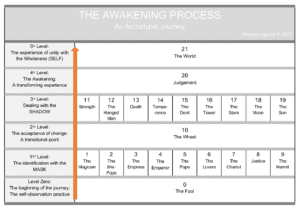Symbols open our mind to new, introspective perspectives. According to Carl Jung, symbols are key to the comprehension of human experience. Myths, dreams images, and various kinds of art all might be considered meaningful expressions of the Archetypes. To say it briefly, the Archetypes are active, psychic structures, which emerge from the Collective Unconscious. They are kinds of abstract patterns condensing general life themes such as ‘the mother’, ‘the child’, ‘the father’, ‘the wise old-man’, etcetera, each represented differently in different cultural contexts (Jung, 1916, 1921, 1934). Despite that they are uncountable, we will focus on three of the major Junguian Archetypes—the Mask (in Latin, Persona), the Shadow, and the Self or the Archetype of Wholeness or Totality. I will explain them in the following sections.
One of the richest symbolic thesaurus in history is the Tarot deck born in the Middle Ages. We chose here The Visconti-Sforza Tarot deck made in Italy about 1432, the oldest known and undoubtedly one of the most beautiful ever. The Tarot’s Major Arcana, in the way we will distribute them on our map, represent, using the Jungian expression, The Heroes’ Journey, which is the archetypal, universal process of consciousness evolution from ignorance to the full awakening. Notice that as we can see on the following chart, the individual identification with a personality style or type is only a step within this whole process.
The Enneagram and the Tarot have in common that they are tools for self-knowledge and human development, although each one can also have other applications. Both systems use numbers to organize the personality styles and the Archetypes of the human journey, respectively, and we also are going to use numbers—with their symbolic meanings—to link both systems.
Not to get lost on the path, we will be guided by the following archetypal map, which comes from integrating the study and my experience with the Enneagram and the 22 Major Arcana.
The awakening process necessarily starts with the self-observation practice (Level Zero). Then we need to identify our own Mask or egotype (1st Level), and keep moving on through a transitional experience of change (2nd Level), to recognize and deal with the Shadow, which is a huge learning opportunity (3rd Level). Finally, we will be able to embrace a transforming experience (4th Level), which leads us into the consciousness of unity with the Wholeness, in which experience we will find our true Self.
(click on the table to see it in a larger format)
Well, let’s get started!
LEVEL ZERO
THE BEGINNING OF THE JOURNEY
The Self-Observation Practice

To start an archetypal journey like this, we should put ourselves in the Fool’s shoes. In other words, we will need to open our mind, and set it free from any prejudice. The freedom of thought is symbolized by the seven feathers on the Fool’s head. When traveling spiritually, nothing better than to go with light-luggage, which means with no prejudice, and with positivity, that is, in a good mood and enthusiastically open to any new experiences coming along. All of these traits correspond to the Fool according to the Tarot tradition.
The Fool stands for an Archetype of the spiritual seeker. He has no prejudices and follows its intuition more than logical thoughts. Although he looks naive, he is always curious about new experiences because he is confident that each new experience involves new learnings. This is why the Fool represents the beginning of the trip. The tradition has assigned two numbers for this Arcanum, 0 and 22. On the one hand, as the seeker, the Fool matches the number 0, the pure potency, also called the cosmic egg (0), from which point all things arise into the existence. This is related to what Jung called indeterminate psychic energy, that is, the energy underlying the entire process of the consciousness evolution—also called individuation process. On the other hand, standing for an enlightened being, the Fool matches the number 22, that is, the human ideal of reaching the total consciousness evolution, being totally awake or enlightened. Thus, this Arcanum represents both the beginning and the end of the human inner trip through 22 stages—each Major Arcanum symbolizes a particular learning in life. The Fool goes through all of them to learn from each new experience.
We start the Fools’ journey with the self-observation practice, as we are progressively noticing and overcoming the prejudices that prevent us from learning. For many people, this journey began the first time they identified themselves with a personality style or type, such as with the Enneagram, and began to focus in those main traits that cause each of us to get stuck in some rigid and automatic reactions.
So, let’s look at some relationships between the nine personality styles and the Major Arcana. (Notice that for space reason, we cannot analyze here all of the symbolic elements present in each Tarot Archetype, but only those which match the most relevant traits of each Enneagram personality style.)
FIRST LEVEL
THE MASK ARCHETYPE
AND THE NINE PERSONALITY STYLES
The Mask—in Latin, persona—is one of the main Jungian Archetypes. This might be considered properly as the personality Archetype. The nine personality styles of the Enneagram, or other personality classifications, are included within this Archetype. For each individual, the Mask is identified with the established identity and social roles from which the person interacts with others. Thus, the Mask becomes that core the person thinks of when he or she says I or Me. Like all of the Archetypes, the Mask has two opposite aspects—we will call them strengths and weaknesses—as we can see in the following.

1. THE MAGICIAN / THE PERFECTIONIST
According to the old Pythagorism, number 1 represents wholeness and perfection itself—in Latin, the word perfectummeans what is fully complete, totally done.
The Magician is represented by an adult, serious man, focused on his task, doing something with instruments on a table. Two of them are a knife and a wand.
Several of these graphic elements symbolize features matching the Perfectionist’s positive traits, such as seriousness, a high sense of responsibility, and a special application of the personal energy onto the doing, practical domain. The Magician knows the Universe’s rules for changing things into something different. He knows how to create solutions quickly. He’s got the magic wand at his fingertips! Similarly, the Perfectionist found ‘magic’ solutions when his mind is at ease and he lets him/herself be in contact with their transcendent Idea, the Holy Perfection. However, if a sword usually symbolizes the energy of anger, here a simple knife on the table represents the Perfectionist’s repression of anger, which leads him to body tightness and many communicational problems.
Strengths. High sense of responsibility, practical-minded, focused on tasks.
Weaknesses. Over-critical, rigidity about formal procedures.

2. THE SHE-POPE / THE GIVER
Number 2 symbolizes the duality between opposite qualities.
We are here in front of a woman with a friendly but engmatic appearance, wearing a religious, large habit with a tiara on her head. She reminds us of the Pope Joan legend.
The She-Pope, better than any other Arcanum, symbolizes the duality of human nature, such as humility/pride, spiritual generosity/manipulative drives, sweetness/rudeness, sincerity/double-dealing. In the Pope Joan legend, she lies about being a man to reach her purpose. All of these traits remind us of the paradoxical ways the Seducer might show him/herself in order to fulfil her or his goals at any cost—which is an egoistic distortion of Holy Will.
Strengths. Great sensibility, self-sacrificing and humanitarian sense to help others—like a religious person.
Weaknesses. Hides selfishness and pride. The tiara on her head indicates that she puts herself over others, on top of the hierarchy of importance.

3. THE EMPRESS / THE PERFORMER
Number 3 represents active harmony and dynamism—which reminds us of the Law of Three. Moreover, according to Aristotle, the 3 relates to overcoming the dualistic opposites (2) by the addition of the another point of view (1)—the tertium quid— which leads to constant progress. These quantities are easy to find among Performers.
To represent the harmonic dynamism and growth that embody the Great Mother Nature, the Empress, she wears a beautiful, gold dress ornamented with flowers and three interlaced rings. And like Mother Nature she wears green gloves, symbolizing the growth of being alive. And Performers feel productive and always energized, seeking naturally constant growth within their personal and professional domains.
Strengths. Producing dynamism, goal-oriented optimism—like Nature’s drive.
Weaknesses. Too much emphasis on the appearance, vanity—an egoic inflation based on an over-self-estimate.
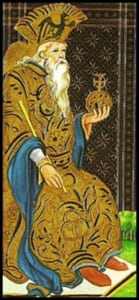
4. THE EMPEROR / THE ARISTOCRAT
Number 4 relates to firmness and stability, like the four legs of a table, or the four giant turtles which the world was seated on according to the ancients’ imagery. The number 4 also refers to the four elements—fire, water, air, earth—that constitute the whole of the material world.
The Emperor holds an orb in his hand as a sign of dominion over the world. For many people it would be difficult to link the Emperor to the personality style Four. It might be because there is a very extended prejudice about Fours, such as lacking firmness and emotional stability. These stereotypes regarding style Four seem to convey the very opposite impression from an Emperor. However, that is just a prejudice. As Daniels & Price (2009) say: “Many people believe that Fours are dominated by their feelings and can’t be counted upon. In fact, Fours often stay steady despite their strong feelings and accomplish a great deal as long as they are moved by the activity. They even have a knack for making the ordinary extraordinary.” And Almaas (2000) notes that, “when disconnected from the Holy Origin, Fours spend a lot of energy to control themselves and their environment”. This overcontrol on the part of Fours matches the Emperor’s special effort to control the portion of the world under his domain.
Strengths. Will to take care of themselves and things under their domain.
Weakness. Irritability and general emotional instability when they lose control over the things they care for. When they loose equanimity, Fours tend to feel misunderstood by the world like an Aristocrat in exile.
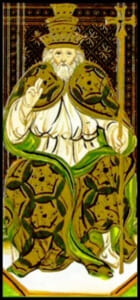
5. THE POPE / THE OBSERVER
Number 5 refers to the power of mind over the four material elements, which is represented by a five-pointed star. According to the Esoteric tradition, the mind is made from an invisible, omnipresent element, the 5th element, the ether. And whoever could control the ether/mind could also control the material world. This perspective is very close to the Five’s underlying, core believe that the most important thing in life is to cultivate the mind because if you can control your mind you can control everything else.
The Pope represents the highest authority in theological matters. If knowledge is power, he is the most powerful man on earth. In the medieval age, when the Tarot was made, the Pope had the last word in many matters, including scientific, philosophical, and religious themes, and only he had full access to secrets libraries. This emphasis on knowledge as a means to having authority regarding various specializations, like the Pope, might be easily found among Fives.
Strengths. Love for knowledge, that leads Five to spend a lot of time and energy to try to understand the interconnection among all the things, which comes from the Holy Idea, Transparency.
Weaknesses. Mental rigidity, too much attachment to tradition, which drives them to isolation—his/her cognitive fixation.
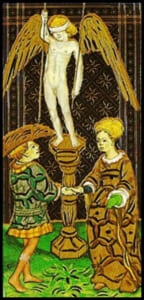
6. THE LOVER / THE LOYAL
Number 6 symbolizes the dynamic tension between two opposites (3+3). According to the philosophic tradition, the number 6 relates to the Greek concept of Kairos, which means the right time to make an important decision. Notice that time is expressed by multiples of 6, as in seconds, minutes, and hours.
The Lover is represented by a short man making a romantic advance toward a beautiful woman. Between them appears Cupid, the Angel of Love encouraging and inspiring the Lover’s decision. Like the Lover, the Loyal one makes decisions and compromises often based more on his or her faith and intuition than on logical reasons, and he or she tends to hold onto engagements and duties even though he or she never stops to fight with their doubts and mental insecurities.
Strengths. Taking risks and holding commitments.
Weaknesses. Too much thinking before making a decision, or making hasty decisions. It depends on whether the person is phobic or counter-phobic.

7. THE CHARIOT / THE ENTHUSIAST
Number 7 represents ordered expansion, which is as result of moving the material elements through the productive dynamism of nature (4+3). According to Gurdjieff, the Law of Seven rules the structure, functioning, and the planned expansion of the universe (Nicoll, 2006). In the same way, we find in the Biblical tradition that the world was created by God according a seven-day schedule.
We can see here a young prince dressed in gold, holding an orb and a wand on his hands, seated on a chariot which is driven by winged, white horses. Like this little rider, the Enthusiast, has the fresh mind of a young prince, plenty of creative ideas and projects, as suggested by the symbol of the white, winged horses. Since their transcendent Idea is the Holy Plan, Sevens are naturally imaginative and optimistic, trusting that all things will go well as time goes by. This is represented in the detail that the little prince drives the Chariot using no reins but only his mind.
Strengths. Optimistic, imaginative, versatile.
Weaknesses. Often might lose contact with the real, concrete requirements needed to accomplish their projects. They fly too much with their winged imagination getting trapped under their fixation, a compulsive pacification based in the air.
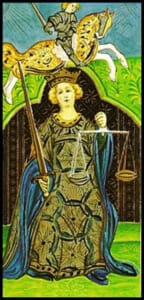
8. JUSTICE / THE BOSS
Number 8 represents conflicts, a clash between two forces or authorities—like a war between two Emperors (4+4).
We can see two images in the card: a seated, calm woman holding a large sword in one hand and a scale in her other hand. And over her head is an angry warrior riding a horse, holding a globe and in full fight mode. Both the calm woman and the angry warrior represent two ways that Eights often show themselves. Notice that, as we said, the sword symbolizes an aggressive energy, and here is the only card of the whole Tarot where we can see two swords which match the fact that, even though they might appear calm, Eights often express anger openly more easily than any other personality style.
Strengths. Assertive; direct to communicate their opinions and impressions; sense of justice.
Weaknesses. Rude, intimidating, defiant, possessive. When losing touch with their transcendent Idea, Holy Truth, they tend to forget the sense of justice in order to please their selfish wishes.

9. THE HERMIT / THE MEDIATOR
Number 9 represents harmony since it comes from three times three (3+3+3). According to the Platonic tradition, the number 9 represents the ideal perfection itself, in contrast with the material perfection that comes from the Pythagoric concept of Tetractys (1+2+3+4).
In the representation of this Archetype, we can see an old, quieted-glance man almost fully dressed in blue. Blue is a concentric color having relaxing proprieties, which matches the easy-going personality style of Nines. However, their minds are very busy and they often get engaged in many activities which are suggested by the red color of his hat and shoes. Red is an exciting color that suggests predisposition to action. Moreover, the Hermit holds a sand clock in his hand, which relates to the fact that Nines really like to take their own time in doing things.
Strengths. Easy-going, quiet, but truly generous in doing things to help others—because their Holy Idea, Love, actually means active love or diligence.
Weaknesses. Laziness and robotic habits—when losing touch with their transcendent Idea.
* * *
As I said, the work with the Mask Archetype—which includes the nine personality styles— is just the first step in the journey of consciousness evolution. So having identified our own Mask, we need to move to the next levels gradually. In this exciting Archetypal Journey our ego will be transformed by accepting the inevitable change, The Wheel, dealing with the Shadow and getting ready to embrace the transpersonal experience of the last Archetypes.
REFERENCES
ALMAAS, A. H. (2000). Facets of Unity: The Enneagram of Holy Ideas. Boston: Shambhala Publications, Inc.
DANIELS, D. & PRICE, V. (2009). The Essential Enneagram. New York: HarperCollins Publishers.
JUNC, C. G. (1916). Lo inconsciente. Buenos Aires: Losada.
————— (1921). Tipos psicológicos. Buenos Aires: Sudamericana.
————— (1934). Arquetipos e inconsciente colectivo. Buenos Aires: Paidós.
NICOLL, M. (2006). Comentarios Psicológicos sobre las Enseñanzas de Gurdjieff y Ouspensky. Buenos Aires: Kier.
—-
Tarot Images from THE VISCONTI-SFORZA TAROT DECK (2005). Torino Italy: Lo Scarabeo.
This Article is a brief, updated version from the original in Spanish, which was presented in the Enneagram Conference in Chile, 2012.


